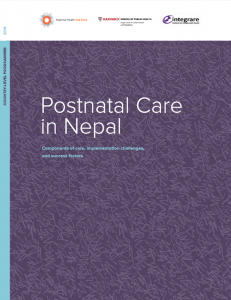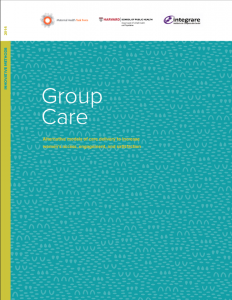Country cases
View a PDF of the brief overview of the country-level cases >>
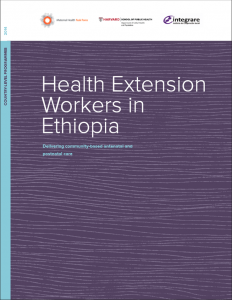 Health Extension Workers in Ethiopia
Health Extension Workers in Ethiopia
View a PDF of the case study >>
The Ethiopian government began its Health Extension Worker (HEW) Programme in 2003. By training young women with at least some schooling to provide basic health services to their communities, the Federal Ministry of Health hoped to improve access to quality primary health care in a country that is predominately rural.
By 2010, Ethiopia had trained 33,819 HEWs who were deployed in 89% of communities throughout the country. While HEWs do not focus exclusively on maternal and child health, they do provide WHO’s recommended Focused Antenatal Care (FANC), connect women to facilities for delivery, provide at least one PNC visit, and coordinate immunizations for newborns. Results have been largely promising, with the percentage of women receiving at least one ANC visit almost doubling from 2000 to 2011. However, linkages with higher-level health services need to be strengthened since the vast majority of women are still giving birth at home and without a skilled attendant.
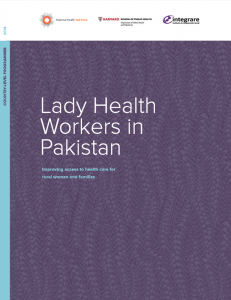 Lady Health Workers in Pakistan
Lady Health Workers in Pakistan
View a PDF of the case study >>
The Lady Health Worker (LHW) Programme began in 1994 to reduce poverty and improve health. With 110,000 LHWs across the country, Pakistan has one of the largest cadres of community health workers in the world. Each LHW has a catchment area of about 1,000 people and is responsible for providing education on reproductive health and nutrition, distributing family planning, immunizing children, and encouraging women to seek ANC–but LHWs do not provide ANC themselves. LHWs have built strong relationships with traditional birth attendants and midwives to ensure pregnant women and mothers receive adequate care. Women who are served by LHWs are more likely to use contraception and to receive early PNC. The program has also contributed to a reduction in maternal and infant mortality in recent years. In order to sustain LHWs and their impact, future attention should focus on ensuring manageable caseloads and adequately integrating LHWs with primary care facilities.
View a PDF of the case study >>
In recent years, Nepal has implemented a variety of programs to improve access to and quality of PNC in the country. While these programs have been implemented by a variety of agencies, most have been run in partnership with the Government of Nepal and have relied heavily on Female Community Health Volunteers (FCHVs) and other cadres of community health workers.
- The Community-Based Neonatal Care Package, for example, aimed to change health-related behaviors in the community and also provide three home visits in the week after delivery for mothers and newborns alike.
- The Nepal Family Health Programme II worked to increase access to family planning as well as basic health services, including postpartum care.
- The Birth Preparedness Package encouraged women and families to plan for their pregnancies as well as the postnatal period, including how to deal with emergency situations.
These programs have been quite successful in increasing uptake of PNC among women in their target areas. As many postnatal programs have been scaled up to a national level, crucial facilitators of success have been thorough, high-quality care guidelines; community buy-in; and an adequate number of appropriately-trained personnel.
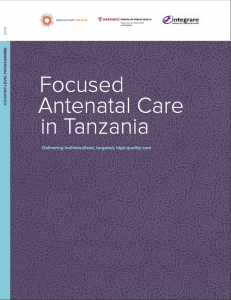 Focused Antenatal Care in Tanzania
Focused Antenatal Care in Tanzania
View a PDF of the case study >>
Tanzania adapted and implemented the WHO-recommended FANC model soon after the guidelines were released in 2002. FANC shifted the focus of ANC from a “risk approach,” which targeted women based on risk factors, to an individualized, targeted approach, which aims to detect complications as they arise.
Tanzania’s FANC model includes four ANC visits: one before 16 weeks, if possible; at 20-24 weeks; at 28-32 weeks; and at 36 weeks of gestation. When the model was implemented, the government hosted trainings on the new guidelines at the district, regional and national levels. Providers in Tanzania were trained on the importance of health promotion, individualized counseling, targeted assessments, and evidence-based interventions. While maternal mortality has declined in recent years and access to ANC has increased, more research is needed to establish the role the FANC model has played in these trends.
Innovative Models
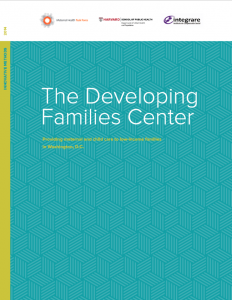 Developing Families Center—Washington, D.C.
Developing Families Center—Washington, D.C.
View a PDF of the case summary >>
View a PDF of the case study >>
The DFC was started in 2000 in Northeast D.C. to provide support programs and primary health care to low-income populations in one of the poorest areas of Washington. In addition to housing the only free-standing birthing center in the District, the organizations within the DFC provide midwife-led antenatal care, nurse-led primary health care, support groups for teen parents, and early childhood development programs. Patients who receive care through the DFC are more satisfied and experience lower rates of Caesarean section, low birthweight, and preterm birth.
View a PDF of the case summary >>
View a PDF of the case study >>
Research has shown that women often do not attend ANC because they see pregnancy and childbirth as healthy life events, lack the financial resources to access ANC, or are unsatisfied with the care and resources provided. This case study highlights group care models that are used during and after pregnancy to build camaraderie between women and encourage them to attend ANC. The various models of group care include Participatory Women’s Groups, CenteringPregnancy, and other less formal group care models. The case study showcases the innovative aspects of these approaches and how they can be implemented widely to improve maternal and newborn health. Anecdotal evidence of these approaches has been promising; however, more rigorous research is needed to closely examine the health outcomes, acceptability and cost-effectiveness of group care models.
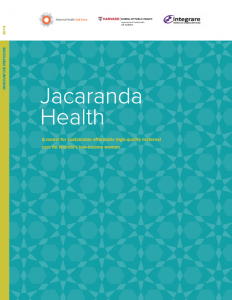 Jacaranda Health—Nairobi, Kenya
Jacaranda Health—Nairobi, Kenya
View a PDF of the case summary >>
View a PDF of the case study >>
Jacaranda Health opened its first clinic in 2011. A social venture, it combines business and clinical innovations to provide women living in Nairobi’s peri-urban areas with high-quality, friendly and affordable maternity care through a network of self-sustaining and scalable clinics. With two brick-and-mortar clinics, the organization provides clients with high-quality individualized ANC delivered by nurse-midwives. Labor and delivery care is also available at the clinic, with postnatal care being provided both at the clinic and across the community. Jacaranda has developed its own electronic record-keeping service, an innovative postpartum family planning campaign, and its own mobile pre-payment service that helps families save for delivery costs. Early results, particularly related to patient satisfaction, have been promising, but more information on scalability is needed.
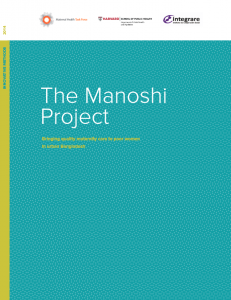 The Manoshi Project—urban Bangladesh
The Manoshi Project—urban Bangladesh
View a PDF of the case summary >>
View a PDF of the case study >>
The Manoshi project was implemented in 2007 to bring skilled care into the informal settlements of six major cities in Bangladesh, with a particular focus on women and children. Manoshi’s Community Health Workers (CHWs) provide high-quality ANC, delivery care, and PNC to all pregnant women within the community, which includes appropriate family planning methods; connecting women with pre-selected referral facilities when necessary; arranging immunization and other care for under-five children; and creating women’s groups to drive community empowerment. Under Manoshi, ANC and PNC coverage have increased while unattended home births have decreased. While overall results are positive, increased support for Manoshi’s CHWS as well as improved connection with the public health system will be vital for the program’s success moving forward.

